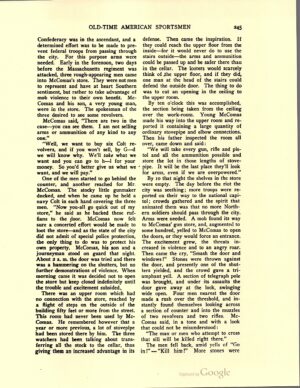- No products in the cart.
Archive

Practicality rules. Plain and simple. Yesterday, like today, the firearms that most found their way into people’s pockets, holsters, handbags, scabbards, and hands were affordable, reliable, and durable. Think of the Colts, S&Ws, Remingtons, Stevens, and Winchesters of the late-19th Century. There were others, but these firms’ products are the ones that dominated the competition by embodying practicality. Today, names like Glock, Sig, Ruger, and yes, S&W are some of the most recognizable names and products whether on duty, defending ourselves, hunting or having fun on the range. Most of our modern arsenals consist of rifles, pistols, and shotguns with lots of light black plastic and durable treatments to the steel. We choose our weapons today based on many things, but for many, it all comes back round to practicality. How much does it cost, how reliable, how modular, how many rounds does it hold?
Sometimes, it is nice to step back in time and forget what would be most practical today and consider what was practical then. A couple years ago I took a 125-year-old Parker double on a pheasant hunt in Kansas. It was much heavier than the Browning A5 I grew up with and took me on a bit of a learning curve with its side by side barrels and double triggers, but it made that hunt special. This weekend I got the bug and took this Remington No. 2 Rolling Block out to the club to try it out. This little single shot rifle sports an octagonal barrel chambered for .32-20 WCF. It has very nice original case colors on the frame and a nice blue finish on the barrel. It was made circa 1889 in Remington’s original headquarters, Ilion, New York.
To load, simply put the hammer into full-cock, roll the breechblock back, insert your cartridge, and roll the breechblock forward. You are ready to fire. The hammer has a strong half-cock notch for a safe way to carry in the field. Once fired, repeat the process and the extractor will push the spent case out a little for you to take out with your fingers.
This would have been a light, handy, simple game-getter or plinker back at the end of the 19th Century. Recoil was very mild from the .32-20 WCF cartridges I was using. I would describe it as a little more stout than a .22 LR. It grouped just fine at 25 yards, obviously a bit high, but I did not adjust the sights. I can imagine many squirrels, rabbits, raccoons, possums, varmints, and other smaller game being taken with this rifle. It may not have the most ballistically efficient cartridge or the potential for a quick follow-up shot, but it did shoot reliably and remains in great shape 129 years later. Maybe it will hunt again someday.

Ancestry Guns was founded out of a passion for two things: history and firearms. I grew up shooting, collecting and hunting, and I grew up with an attentive ear when stories were being told, whether at a family gathering or in a classroom. My passion for history ultimately led my somewhat aimless university career to a B.A. in history. I had no idea that these two passions, combined with a desire to be an entrepreneur would lead me to begin this business.
I dare say that every one of the relics I acquire for my ever revolving collection has some story worth telling. Some are more vocal and forthcoming than others. Any time I can give that piece of history a larger voice, I will.
Below is a fascinating article, from the May 1909 issue of Field And Stream, that I discovered while researching the maker of this rifle. It tells of well-renowned gun maker, Alexander McComas, who lived in the city of Baltimore during the beginning of hostilities of the American Civil War. The article describes the setting: “The city was in a terrible turmoil. Union sentiment hardly dared to express itself; sympathy for a Southern Confederacy was in the ascendant, and a determined effort was to be made to prevent federal troops from passing through the city.” Against that backdrop, our smith, along with his son and an assistant foiled several Confederate provocateurs and then an entire mob from raiding his shop for weapons to use against the federal troops coming through on their way to Washington D.C.
How did they do it? Read the article to find out.
https://www.ancestryguns.com/shop/beautiful-antique-a-mccomas-half-stock-long-rifle-made-in-baltimore-maryland-usa/






